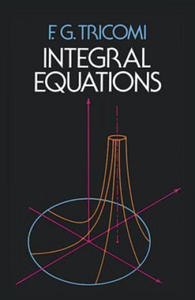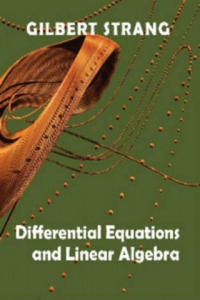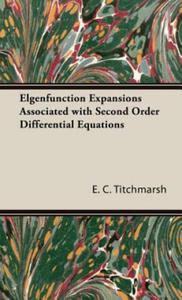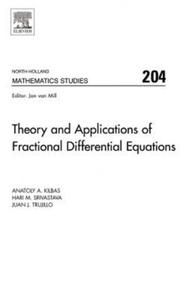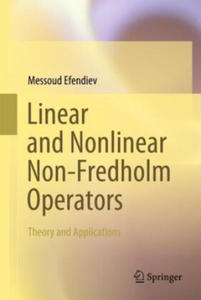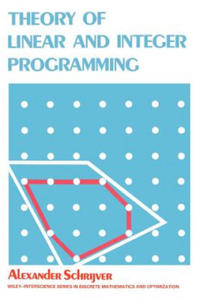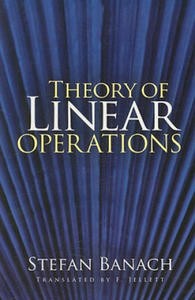libristo linear integral equations 2566831
- znaleziono 30 produkty w 4 sklepach
Linear Integral Equations Springer-Verlag New York Inc.
Książki / Literatura obcojęzyczna
This book, now in its third edition, is an excellent introductory text for students, scientists and engineers who want to learn the basic theory of linear integral equations and their numerical solution. Features problems at the end of each chapter.
Sklep: Libristo.pl
Integral Equations Dover Publications Inc.
Książki / Literatura obcojęzyczna
1. Volterra Equations 1.1 A Mechanical Problem Leading to an Integral Equation 1.2 Integral Equations and Algebraic Systems of Linear Equations 1.3 Volterra Equations 1.4 L subscript 2-Kernels and Functions 1.5 Solution of Volterra Integral Equations of the Second Kind 1.6 Volterra Equations of the First Kind 1.7 An Example 1.8 Volterra Integral Equations and Linear Differential Equations 1.9 Equations of the Faltung type (Closed Cycle Type) 1.10 Transverse Oscillations of a Bar 1.11 Application to the Bessel Functions 1.12 Some Generalizations of the Theory of Volterra Equations 1.13 Non-Linear Volterra Equations2. Fredholm Equations 2.1 Solution by the Method of Successive Approximations: Neumann's Series 2.2 An Example 2.3 Fredholm's Equations with Pincherle-Goursat Kernels 2.4 The Fredholm Theorem for General Kernels 2.5 The Formulae of Fredholm 2.6 Numerical Solution of Integral Equations 2.7 The Fredholm Solution of the Dirichlet Problem3. Symmetric Kernels and Orthogonal Systems of Functions 3.1 Introductory Remarks and a Process of Orthogonalization 3.2 Approximation and Convergence in the Mean 3.3 The Riesz-Fischer Theorem 3.4 Completeness and Closure 3.5 Completeness of the Trigonometric System and of the Polynomials 3.6 Approximation of a General L subscript 2-Kernel by Means of PG-Kernels 3.7 Enskog's Method 3.8 The Spectrum of a Symmetric Kernel 3.9 The Bilinear Formula 3.10 The Hilbert-Schmidt Theorem and Its Applications 3.11 Extremal Properties and Bounds for Eigenvalues 3.12 Positive Kernels--Mercer's Theorem 3.13 Connection with the Theory of Linear Differential Equations 3.14 Critical Velocities of a Rotating Shaft and Transverse Oscillations of a Beam 3.15 Symmetric Fredholm Equations of the First Kind 3.16 Reduction of a Fredholm Equation to a Similar One with a Symmetric Kernel 3.17 Some Generalizations 3.18 Vibrations of a Membrane4. Some Types of Singular or Non-Linear Integral Equations 4.1 Orientation and Examples 4.2 Equations with Cauchy's Principal Value of an Integral and Hilbert's Transformation 4.3 The Finite Hilbert Transformation and the Airfoil Equation 4.4 Singular Equations of the Carleman Type 4.5 General Remarks About Non-Linear Integral Equations 4.6 Non-Linear Equations of the Hammerstein Type 4.7 Forced Oscillations of Finite AmplitudeAppendix I. Algebraic Systems of Linear EquationsAppendix II. Hadamard's Theorem Exercises; References; Index
Sklep: Libristo.pl
Introduction To Nonlinear Differential And Integral Equations
Książki Obcojęzyczne>Angielskie>Mathematics & science>Mathematics>Optimization>Linear programmingKsiążki Obcojęzyczne>Angielskie>...
0x002b251600000000
Sklep: Gigant.pl
The Cauchy Problem For Non - Lipschitz Semi - Linear Parabolic Partial Differential Equations
Książki Obcojęzyczne>Angielskie>Mathematics & science>Mathematics>Applied mathematics>Mathematical modellingKsiążki Obcojęzyczne>Ang...
0x0016224800000000
Sklep: Gigant.pl
Differential Equations and Linear Algebra Wellesley-Cambridge Press,U.S.
Książki / Literatura obcojęzyczna
Differential equations and linear algebra are two central topics in the undergraduate mathematics curriculum. This innovative textbook allows the two subjects to be developed either separately or together, illuminating the connections between two fundamental topics, and giving increased flexibility to instructors. It can be used either as a semester-long course in differential equations, or as a one-year course in differential equations, linear algebra, and applications. Beginning with the basics of differential equations, it covers first and second order equations, graphical and numerical methods, and matrix equations. The book goes on to present the fundamentals of vector spaces, followed by eigenvalues and eigenvectors, positive definiteness, integral transform methods and applications to PDEs. The exposition illuminates the natural correspondence between solution methods for systems of equations in discrete and continuous settings. The topics draw on the physical sciences, engineering and economics, reflecting the author's distinguished career as an applied mathematician and expositor.
Sklep: Libristo.pl
Elgenfunction Expansions Associated With Second Order Differential Equations Read Books
Książki / Literatura obcojęzyczna
EIGENFUNCTION EXPANSIONS ASSOCIATED WITH SECOND-ORDER DIFFERENTIAL EQUATIONS by E. C. TITCHMARSH. PREFACE: THE idea of expanding an arbitrary function in terms of the solutions of a second-order differential equation goes back to the time of Sturm and Liouville, more than a hundred years ago. The first satisfactory proofs were constructed by various authors early in the twentieth century. Later, a general theory of the singular cases was given by Weyl, who-based i on the theory of integral equations. An alternative method, proceeding via the general theory of linear operators in Hilbert space, is to be found in the treatise by Stone on this subject. Here I have adopted still another method. Proofs of these expansions by means of contour integration and the calculus of residues were given by Cauchy, and this method has been used by several authors in the ordinary Sturm-Liouville case. It is applied here to the general singular case. It is thus possible to avoid both the theory of integral equations and the general theory of linear operators, though of course we are sometimes doing no more than adapt the latter theory to the particular case considered. The ordinary Sturm-Liouville expansion is now well known. I therefore dismiss it as rapidly as possible, and concentrate on the singular cases, a class which seems to include all the most interesting examples. In order to present a clear-cut theory in a reasonable space, I have had to reject firmly all generalizations. Many of the arguments used extend quite easily to other cases, such as that of two simultaneous first-order equations. It seems that physicists are interested in some aspects of these questions. If any physicist finds here anything that he wishes to know, I shall indeed be delighted but it is to mathematicians that the book is addressed. I believe in the future of mathematics for physicists, but it seems desirable that a writer on this subject should understand physics as well as mathematics. E. C. T. Contents include: I. THE STUEM-LIOUVILLE EXPANSION ... 1 II. THE SINGULAB CASE SERIES EXPANSIONS . . 19 III. THE GENERAL SINGULAR CASE . . . .39 IV. EXAMPLES 69 V. THE NATURE OF THE SPECTRUM . . .97 VI. A SPECIAL CONVERGENCE THEOREM . . .118 VII. THE DISTRIBUTION OF THE EIGENVALUES . . 124 VIII. FURTHER APPROXIMATIONS TO JV A . . .135 IX. CONVERGENCE OF THE SERIES EXPANSION UNDER FOUBIER CONDITIONS 148 X. SUMMABILITY OF THE SERIES EXPANSION . . 163 REFERENCES 172 THE STURM-LIOUVILLE EXPANSION 1.1. I
Sklep: Libristo.pl
Theory and Applications of Fractional Differential Equations Elsevier Science & Technology
Książki / Literatura obcojęzyczna
This monograph provides the most recent and up-to-date developments on fractional differential and fractional integro-differential equations involving many different potentially useful operators of fractional calculus. The subject of fractional calculus and its applications (that is, calculus of integrals and derivatives of any arbitrary real or complex order) has gained considerable popularity and importance during the past three decades or so, due mainly to its demonstrated applications in numerous seemingly diverse and widespread fields of science and engineering. Some of the areas of present-day applications of fractional models include Fluid Flow, Solute Transport or Dynamical Processes in Self-Similar and Porous Structures, Diffusive Transport akin to Diffusion, Material Viscoelastic Theory, Electromagnetic Theory, Dynamics of Earthquakes, Control Theory of Dynamical Systems, Optics and Signal Processing, Bio-Sciences, Economics, Geology, Astrophysics, Probability and Statistics, Chemical Physics, and so on.In the above-mentioned areas, there are phenomena with estrange kinetics which have a microscopic complex behaviour, and their macroscopic dynamics can not be characterized by classical derivative models. The fractional modelling is an emergent tool which use fractional differential equations including derivatives of fractional order, that is, we can speak about a derivative of order 1/3, or square root of 2, and so on. Some of such fractional models can have solutions which are non-differentiable but continuous functions, such as Weierstrass type functions. Such kinds of properties are, obviously, impossible for the ordinary models. What are the useful properties of these fractional operators which help in the modelling of so many anomalous processes? From the point of view of the authors and from known experimental results, most of the processes associated with complex systems have non-local dynamics involving long-memory in time, and the fractional integral and fractional derivative operators do have some of those characteristics.This book is written primarily for the graduate students and researchers in many different disciplines in the mathematical, physical, engineering and so many others sciences, who are interested not only in learning about the various mathematical tools and techniques used in the theory and widespread applications of fractional differential equations, but also in further investigations which emerge naturally from (or which are motivated substantially by) the physical situations modelled mathematically in the book. This monograph consists of a total of eight chapters and a very extensive bibliography. The main objective of it is to complement the contents of the other books dedicated to the study and the applications of fractional differential equations.The aim of the book is to present, in a systematic manner, results including the existence and uniqueness of solutions for the Cauchy type problems involving nonlinear ordinary fractional differential equations, explicit solutions of linear differential equations and of the corresponding initial-value problems through different methods, closed-form solutions of ordinary and partial differential equations, and a theory of the so-called sequential linear fractional differential equations including a generalization of the classical Frobenius method, and also to include an interesting set of applications of the developed theory. It is mainly application oriented and it contains a complete theory of Fractional Differential Equations. It can be used as a postgraduate-level textbook in many different disciplines within science and engineering and it contains an up-to-date bibliography. It provides problems and directions for further investigations. Fractional Modelling is an emergent tool with demonstrated applications in numerous seemingly diverse and widespread fields of science and engineering. It contains many examples.
Sklep: Libristo.pl
Linear and Nonlinear Non-Fredholm Operators Springer, Berlin
Książki / Literatura obcojęzyczna
This book is devoted to a new aspect of linear and nonlinear non-Fredholm operators and its applications. The domain of applications of theory developed here is potentially much wider than that presented in the book. Therefore, a goal of this book is to invite readers to make contributions to this fascinating area of mathematics.First, it is worth noting that linear Fredholm operators, one of the most important classes of linear maps in mathematics, were introduced around 1900 in the study of integral operators. These linear Fredholm operators between Banach spaces share, in some sense, many properties with linear maps between finite dimensional spaces. Since the end of the previous century there has been renewed interest in linear - nonlinear Fredholm maps from a topological degree point of view and its applications, following a period of "stagnation" in the mid-1960s. Now, linear and nonlinear Fredholm operator theory and the solvability of corresponding equations both from the analytical and topological points of view are quite well understood.Also noteworthy is, that as a by-product of our results, we have obtained an important tool for modelers working in mathematical biology and mathematical medicine, namely, the necessary conditions for preserving positive cones for systems of equations without Fredholm property containing local - nonlocal diffusion as well as terms for transport and nonlinear interactions.
Sklep: Libristo.pl
Theory of Linear & Integer Programming John Wiley & Sons Inc
Książki / Literatura obcojęzyczna
Theory of Linear and Integer Programming Alexander Schrijver Centrum voor Wiskunde en Informatica, Amsterdam, The Netherlands This book describes the theory of linear and integer programming and surveys the algorithms for linear and integer programming problems, focusing on complexity analysis. It aims at complementing the more practically oriented books in this field. A special feature is the authora s coverage of important recent developments in linear and integer programming. Applications to combinatorial optimization are given, and the author also includes extensive historical surveys and bibliographies. The book is intended for graduate students and researchers in operations research, mathematics and computer science. It will also be of interest to mathematical historians.Contents 1 Introduction and preliminaries; 2 Problems, algorithms, and complexity; 3 Linear algebra and complexity; 4 Theory of lattices and linear diophantine equations; 5 Algorithms for linear diophantine equations; 6 Diophantine approximation and basis reduction; 7 Fundamental concepts and results on polyhedra, linear inequalities, and linear programming; 8 The structure of polyhedra; 9 Polarity, and blocking and anti--blocking polyhedra; 10 Sizes and the theoretical complexity of linear inequalities and linear programming; 11 The simplex method; 12 Primal--dual, elimination, and relaxation methods; 13 Khachiyana s method for linear programming; 14 The ellipsoid method for polyhedra more generally; 15 Further polynomiality results in linear programming; 16 Introduction to integer linear programming; 17 Estimates in integer linear programming; 18 The complexity of integer linear programming; 19 Totally unimodular matrices: fundamental properties and examples; 20 Recognizing total unimodularity; 21 Further theory related to total unimodularity; 22 Integral polyhedra and total dual integrality; 23 Cutting planes; 24 Further methods in integer linear programming; Historical and further notes on integer linear programming; References; Notation index; Author index; Subject index
Sklep: Libristo.pl
Theory of Linear Operations Dover Publications Inc.
Książki / Literatura obcojęzyczna
Written by the founder of functional analysis, this is the first text on linear operator theory. Additional topics include the calculus of variations and theory of integral equations. 1987 edition.
Sklep: Libristo.pl
Mathematical Methods in Physics and Engineering Dover Publications Inc.
Książki / Literatura obcojęzyczna
PrefaceCHAPTER 1. Linear Algebra1.1 Linear Equations. Summation Convention1.2 Matrices1.3 Determinants1.4 Systems of Linear Algebraic Equations. Rank of a Matrix1.5 Vector Spaces1.6 Scalar Product1.7 Orthonormal Basis. Linear Transformations1.8 Quadratic Forms. Hermitian Forms1.9 Systems of Ordinary Differential Equations. Vibration Problems1.10 Linear ProgrammingCHAPTER 2. Hilbert Spaces2.1 Infinite-dimensional Vector Spaces. Function Spaces2.2 Fourier Series2.3 Separable Hilbert Spaces2.4 The Projection Theorem2.5 Linear Functionals2.6 Weak Convergence2.7 Linear Operators2.8 Completely Continuous OperatorsCHAPTER 3. Calculus of Variations3.1 Maxima and Minima of Functions. Lagrange Multipliers3.2 Maxima and Minima of Functionals. Euler's Equation3.3 Hamilton's Principle. Lagrange's Equations3.4 Theory of Small Vibrations3.5 The Vibrating String3.6 Boundary-value Problems of Mathematical Physics3.7 Eigenvalues and Eigenfunctions3.8 Eigenfunction Expansions3.9 Upper and Lower Bounds for EigenvaluesCHAPTER 4. Boundary-value Problems. Separation of Variables4.1 Orthogonal Coordinate Systems. Separation of Variables4.2 Sturm-Liouville Problems4.3 Series Solutions of Ordinary Differential Equations4.4 Series Solutions of Boundary-value ProblemsCHAPTER 5. Boundary-value Problems. Green's Functions5.1 Nonhomogeneous Boundary-value Problems5.2 One-dimensional Green's Functions5.3 Generalized Functions5.4 Green's Functions in Higher Dimensions5.5 Problems in Unbounded Regions5.6 A Problem in Diffraction TheoryCHAPTER 6. Integral Equations6.1 Integral-equation Formulation of Boundary-value Problems6.2 Hilbert-Schmidt Theory6.3 Fredholm Theory6.4 Integral Equations of the First KindCHAPTER 7. Analytic Function Theory7.1 Introduction7.2 Analytic Functions7.3 Elementary Functions7.4 Complex Integration7.5 Integral Representations7.6 Sequences and Series7.7 Series Representations of Analytic Functions7.8 Contour Integration7.9 Conformal Mapping7.10 Potential TheoryCHAPTER 8. Integral Transform Methods8.1 Fourier Transforms8.2 Applications of Fourier Transforms. Ordinary Differential Equations8.3 Applications of Fourier Transforms. Partial Differential Equations8.4 Applications of Fourier Transforms. Integral Equations8.5 Laplace Transforms. Applications8.6 Other Transform TechniquesIndex
Sklep: Libristo.pl
Applied Complex Variable Dover Publications Inc.
Książki / Literatura obcojęzyczna
Part I. Analytic Function TheoryChapter 1. The Complex Number Plane 1.1 Introduction 1.2 Complex Numbers 1.3 The Complex Plane 1.4 Point Sets in the Plane 1.5 Stereographic Projection. The Extended Complex Plane 1.6 Curves and RegionsChapter 2. Functions of a Complex Variable 2.1 Functions and Limits 2.2 Differentiability and Analyticity 2.3 The Cauchy-Riemann Conditions 2.4 Linear Fractional Transformations 2.5 Transcendental functions 2.6 Riemann SurfacesChapter 3. Integration in the Complex Plane 3.1 Line Integrals 3.2 The Definite Integral 3.3 Cauchy's Theorem 3.4 Implications of Cauchy's Theorem 3.5 Functions Defined by Integration 3.6 Cauchy Formulas 3.7 Maximum Modulus PrincipleChapter 4. Sequences and Series 4.1 Sequences of Complex Numbers 4.2 Sequences of Complex Functions 4.3 Infinite Series 4.4 Power Series 4.5 Analytic Continuation 4.6 Laurent Series 4.7 Double Series 4.8 Infinite Products 4.9 Improper Integrals 4.10 The Gamma FunctionChapter 5. Residue Calculus 5.1 The Residue Theorem 5.2 Evaluation of Real Integrals 5.3 The Principle of the Argument 5.4 Meromorphic Functions 5.5 Entire FunctionsPart II. Applications of Analytic Function TheoryChapter 6. Potential Theory 6.1 Laplace's Equation in Physics 6.2 The Dirichlet Problem 6.3 Green's Functions 6.4 Conformal Mapping 6.5 The Schwarz-Christoffel Transformation 6.6 Flows with Sources and Sinks 6.7 Volume and Surface Distributions 6.8 Singular Integral EquationsChapter 7. Ordinary Differential Equations 7.1 Separation of Variables 7.2 Existence and Uniqueness Theorems 7.3 Solution of a Linear Second-Order Differential Equation Near an Ordinary Point 7.4 Solution of a Linear Second-Order Differential Equation Near a Regular Singular Point 7.5 Bessel Functions 7.6 Legendre Functions 7.7 Sturm-Liouville Problems 7.8 Fredholm Integral EquationsChapter 8. Fourier Transforms 8.1 Fourier Series 8.2 The Fourier Integral Theorem 8.3 The Complex Fourier Transform 8.4 Properties of the Fourier Transform 8.5 The Solution of Ordinary Differential Equations 8.6 The Solution of Partial Differential Equations 8.7 The Solution of Integral EquationsChapter 9. Laplace Transforms 9.1 From Fourier to Laplace Transform 9.2 Properties of the Laplace Transform 9.3 Inversion of Laplace Transforms 9.4 The Solution of Ordinary Differential Equations 9.5 Stability 9.6 The Solution of Partial Differential Equations 9.7 The Solution of Integral EquationsChapter 10. Asymptotic Expansions 10.1 Introduction and Definitions 10.2 Operations on Asymptotic Expansions 10.3 Asymptotic Expansion of Integrals 10.4 Asymptotic Solutions of Ordinary Differential Equations References; Index
Sklep: Libristo.pl
Boundary Element Method for Impedance and Optical Tomoggraphy Politechnika Warszawska
MEDYCYNA
There is a lot of excellent books devoted the Boundary Element Method (BEM). That is why I would not dare to write one more. The main goal of this book is only to show the problems of modelling the forward problems of Diffusive Optical Tomography (DOT) or Electrical Impedance Tomography (EIT) when the Boundary Element is used in 2D or 3D space. The modern Inverse Problems are solved by the iterative process in which we have to solve many times the forward problems for which the design parameters are improved due to the Sensitivity Analysis (SA). The scope of this book is limited to the forward problems and methods presentation of their effective solution in 2D and 3D space with the aid of the Boundary Element Method. The special attention was paid to the basic of the BEM because majority of the monographes devoted this method, do not pay enough attention to the problems of singular integrals integrations. This problem is already solved by many famous authors ( maybe with the exception of the 3D Galerkin approach) but is spread in the literature, in most cases, not easily accessible. That is why it seems to be reasonable to present this problem in full details in this work. A lot of attention was devoted to the problem of modelling of the infant head for the DOT. The BEM seems to be more elastic tool than the FEM. This work tries to prove this opinion. Spis treści: List of symbols Introduction 1. Two-dimensional potential problems 1.1. Introduction 1.2. Laplace equation 1.2.1. Division of the boundary into constant boundary elements 1.2.2. Numerical integration of the kernels 1.2.3. Division of the boundary into linear boundary elements 1.2.4. Numerical integration of the kernels 1.2.5. Division of the boundary into quadratic boundary elements 1.2.6. Numerical integration of the kernels 1.2.7. Numerical integration of the c(r) coefficient 1.2.8. Internal points calculation 1.2.9. Symbolic calculation 1.3. Diffusion equation 1.3.1. Treatment of singularity 1.3.2. Internal points calculation 1.3.3. Example 1.4. Diffusion equation in frequency domain 1.4.1. Treatment of singularity 1.4.2. Internal points calculation 1.5. Examples 1.5.1. Cartesian coordinate system 1.5.2. Polar coordinate system 1.5.3. Distributed source for a diffusion model for light transport 1.5.4. Point source located on the boundary for a diffusion model for light transport 1.5.5. Point source located inside the region for a diffusion model for light transport 1.5.6. Comparison FEM and BEM results of calculation 1.5.7. Conclusion 1.6. Anisotropic medium 1.6.1. Anisotropy model 1.6.2. Treatment of singularity 1.6.3. Comparison FEM and BEM results 1.7. Galerkin formulation of boundary integral equations 1.7.1. Analytical integrations of coincident integrands 1.7.2. Numerical integrations of coincident integrands 2. Three-dimensional potential problems 2.1. Introduction 2.2. Singular and nearly singular integrals 2.3. Governing equations 2.4. Zero-order interpolation functions 2.4.1. Jacobian 2.4.2. Integration of non-singular integrals over the triangle 2.4.3. Integration of singular integrals 2.5. First-order interpolation functions 2.6. Second-orderinterpolation functions 2.6.1. Triangular boundary elements 2.6.2. Numerical integration of singular integrals 2.6.3. Quadrilateral boundary elements 2.6.4. Integration of non-singular integrals over the square 2.6.5. Integration of singular integrals over the square 2.7. Treatment of Boundary Conditions 2.7.1. Dirichlet boundary conditions 2.7.2. Neumann boundary conditions 2.7.3. Robin boundary conditions 2.7.4. Mixed boundary conditions 2.8. Non-homogeneity 2.9. Index mismatched diffusive/diffusive interfaces 2.9.1. Approximate interface conditions 2.9.2. Complete interface conditions 2.10. Numerical examples 2.10.1. Cube 2.10.2. Two concentric spheres 2.10.3. The proximity effect 2.10.4. Results for spatially non-homogeneous region in 2D space 3. Diffusion model for light transport in the frequency domain 3.1. Governing equations 3.1.1. Two dimensional space 3.1.2. Three dimensional space 3.1.3. The Boundary Element Method 3.2. Numerical Implementation 3.2.1. Jacobian 3.2.2. Matrix Assembly 3.3. Numerical integration of singular integrals in 3D 3.3.1. Mapping formula for triangular constant element 3.3.2. Isoparametric triangular quadratic element 3.3.3. Isoparametric quadrilateral quadratic element 3.4. Results for 3D 3.4.1. Validation of numerical results 3.4.2. Measures of the accuracy 3.4.3. Quadratic meshing 3.5. Multilayered model of the neonatal head 4. Light propagation in diffusive media with non-scattering regions 4.1. Introduction 4.2. Governing equations for non-scattering sphere embedded in a diffusive spherical region 4.2.1. The Boundary Element Method 4.2.2. Matrix form of integral equations 4.3. The Form Factor 4.3.1. The Form Factor calculated analytically 4.3.2. The Form Factor calculated numerically 4.4. Results 4.4.1. The steady state 4.4.2. The frequency domain solution - 100 MHz 4.5. Non-scattering gap between two diffusive regions of a spherical shape 4.5.1. Form Factor calculated analytically 4.5.2. Visibility function calculated analytically 4.5.3. Visibility function calculated numerically 4.5.4. Point in triangle test 4.5.5. Integral equations 4.5.6. Matrix form of integral equations 4.6. Results for the void gap 4.6.1. The steady state 4.6.2. The frequency domain solution - 100 MHz 4.7. Consistency checks for BEM solutions 4.7.1. Diffusion equation case 4.7.2. Radiosity-Diffusion equation case 4.8. Nuutti's 2D test example 4.8.1. Analytical solution for diffusive boundary conditions 4.8.2. Analytical solution for P1 boundary conditions 4.8.3. Numerical results 4.8.4. Multilayered neonatal head model with the CSF layer 4.9. Conclusion 5. BEM formulation for thin layers 5.1. Introduction 5.2. Standard BEM formulation 5.3. Modification for closely spaced surfaces 5.4. Integration of singular integrals 5.5. Future work 5.6. Conclusion 6. Wavelet based techniques for CPU time reduction 6.1. Discrete wavelet transform 6.2. Time acceleration 6.3. DWT with permutations 6.4. DWT when the size of the coefficient matrix is not a number equal to 2n 6.5. Conclusion 7. FEM-BEM coupling 7.1. 2D space 7.1.1. Incorporating the BE equations to the FE ones 7.2. Numerical examples 7.2.1. Simple benchmark problem 7.2.2. Two squares one immersed in the other 7.2.3. Concentric circles 7.3. 2D void comparison 7.3.1. Boundary conditions at diffusive/non-diffusive interfaces 7.3.2. P1 boundary conditions 7.3.3. Diffusive boundary conditions 8. Miscellaneous 8.1. Introduction to FEM mixed formulation 8.2. Mixed formulation for Laplace equation 8.2.1. Discretization of mixed forms 8.2.2. Robin boundary conditions 8.3. Mixed formulation for Diffusion equation 8.3.1. Three nodes triangle with three degrees of freedom-P1 triangle 8.3.2. Three nodes triangle with the middle sides nodes 8.3.3. Three nodes triangle with a bubble function at the barycenter - P1 + triangle Bibliography
Sklep: Księgarnia Techniczna
Modern Quantum Chemistry Dover Publications Inc.
Książki / Literatura obcojęzyczna
Preface to Revised edition Preface1. Mathematical Review 1.1 Linear Algebra 1.1.1 Three-dimensional vector algebra 1.1.2 Matrices 1.1.3 Determinants 1.1.4 N-Dimensional Complex Vector spaces 1.1.5 Change of Basis 1.1.6 The Eigenvalue Problem 1.1.7 Functions of Matrices 1.2 Orthogonal functions, Eigenfunctions, and Operators 1.3 The Variation Method 1.3.1 The Variation principle 1.3.2 The Linear Variational Problem Notes, Further Reading2. Many Electron Wave functions and operators 2.1 The Electronic Problem 2.1.1 Atomic Units 2.1.2 The Born-Oppenheimer Approximation 2.1.3 The Antisymmetry or Pauli Exclusion Principle 2.2 Orbitals, Slater Determinants, and Basis functions 2.2.1 Spin Orbitals and Spatial Orbitals 2.2.2 Hartree Products 2.2.3 Slater Determinants 2.2.4 The Hartree-Fock Approximation 2.2.5 The Minimal Basis H subscript 2 Model 2.2.6 Excited Determinants 2.2.7 Form of the Exact Wave function and Configuration Interaction 2.3 Operators and Matrix Elements 2.3.1 Minimal Basis H subscript 2 matrix Elements 2.3.2 Notations for One- and Two-Electron Integrals 2.3.3 General Rules for Matrix Elements 2.3.4 Derivation of the Rules for Matrix Elements 2.3.5 Transition from Spin Orbitals to Spatial Orbitals 2.3.6 Coulomb and Exchange Integrals 2.3.7 Pseudo-Classical interpretation of Determinantal Energies 2.4 Second Quantization 2.4.1 Creation and annihilation Operators and Their Anticommutation Relations 2.4.2 Second-Quantized Operators and Their Matrix Elements 2.5 Spin-Adapted Configurations 2.5.1 Spin Operators 2.5.2 Restricted Determinants and Spin-Adapted Configurations 2.5.3 Unrestricted Determinants Notes, Further Reading3. The Hartree-Fock Approximation 3.1 The Hartree-Fock Equations 3.1.1 The Coulomb and Exchange Operators 3.1.2 The Fock Operator 3.2 Derivation of the Hartree-Fock Equations 3.2.1 Functional Variation 3.2.2 Minimization of the Energy of a Single Determinant 3.2.3 The Canonical Hartree-Fock Equations 3.3 Interpretation of Solutions to the Hartree-Fock Equations 3.3.1 Orbital energies and Koopmans' Theorem 3.3.2 Brillouin's Theorem 3.3.3 The Hartree-Fock Hamiltonian 3.4 Restricted Closed-Shell hartree-Fock: The Roothaan Equations 3.4.1 Closed-Shell Hartree-Fock: Restricted Spin Orbitals 3.4.2 Introduction of a Basis: The Roothaan Equations 3.4.3 The Charge Density 3.4.4 Expression for the Fock Matrix 3.4.5 Orthogonalization of the Basis 3.4.6 The SCF Procedure 3.4.7 Expectation Values and Population Analysis 3.5 Model Calculations on H subscript 2 and HeH superscript + 3.5.1 The 1s Minimal STO-3G Basis Set 3.5.2 STO-3G H subscript 2 3.5.3 An SCF Calculation on STO-3G HeH superscript + 3.6 Polyatomic Basis Sets 3.6.1 Contracted Gaussian functions 3.6.2 Minimal Basis Sets: STO-3G 3.6.3 Double Zeta Basis Sets: 4-31G 3.6.4 Polarized Basis Sets: 6-31G and 6-31G 3.7 Some Illustrative Closed-Shell Calculations 3.7.1 Total Energies 3.7.2 Ionization Potentials 3.7.3 Equilibrium Geometries 3.7.4 Population Analysis and Dipole Moments 3.8 Unrestricted Open-Shell Hartree-Fock: The Pople-Nesbet Equations 3.8.1 Open-Shell Hartree-Fock: Unrestricted Spin Orbitals 3.8.2 Introduction of a Basis: The Pople-Nesbet Equations 3.8.3 Unrestricted Density Matrices 3.8.4 Expression for the Fock Matrices 3.8.5 Solution of the Unrestricted SCF Equations 3.8.6 Illustrative Unrestricted Calculations 3.8.7 The Dissociation Problem and its Unrestricted Solution Notes, Further Reading4. Configuration Interaction 4.1 Multiconfigurational Wave Functions and the Structure of the Full CI Matrix 4.1.1 Intermediate Normalization and an Expression for the Correlation Energy 4.2 Doubly Excited CI 4.3 Some Illustrative Calculations 4.4 Natural Orbitals and the One-Particle Reduced Density Matrix 4.5 The Multiconfiguration Self-Consistent Field (MCSCF) and Generalized Valence Bond (GVB) Methods 4.6 Truncated CI and the Size-Consistency Problem Notes, Further Reading5. Pair and Coupled-Pair Theories 5.1 The Independent Electron Pair Approximation (IEPA) 5.1.1 Invariance under Unitary Transformations: an example 5.1.2 Some Illustrative Calculations 5.2 Coupled-Pair Theories 5.2.1 The Coupled Cluster Approximation (CCA) 5.2.2 The Cluster Expansion of the Wave Function 5.2.3 Linear CCA and the Coupled Electron Pair Approximation (CEPA) 5.2.4 Some Illustrative Calculations 5.3 Many-Electron Theories with Single Particle Hamiltonians 5.3.1 The Relaxation Energy via CI, IEPA, CCA, and CEPA 5.3.2 The Resonance Energy of Polyenes in Hückel Theory Notes, Further Reading6. Many-Body Perturbation Theory 6.1 Rayleigh-Schrödinger (RS) Perturbation Theory 6.2 Diagrammatic Representation of RS Perturbation Theory 6.2.1 Diagrammatic Perturbation Theory for 2 States 6.2.2 Diagrammatic Perturbation Theory for N States 6.2.3 Summation of Diagrams 6.3 Orbital Perturbation Theory: One-Particle Perturbations 6.4 Diagrammatic Representation of Orbital Perturbation Theory 6.5 Perturbation Expansion of the Correlation Energy 6.6 The N-Dependence of the RS Perturbation Expansion 6.7 Diagrammatic Representation of the Perturbation Expansion of the Correlation Energy 6.7.1 Hugenholtz Diagrams 6.7.2 Goldstone Diagrams 6.7.3 Summation of Diagrams 6.7.4 What Is the Linked Cluster Theorem? 6.8 Some Illustrative Calculations Notes, Further Reading7. The One-particle Many-Body Green's Function 7.1 Green's Functions in single Particle Systems 7.2 The One-Particle Many-Body Green's Function 7.2.1 The Self-Energy 7.2.2 The solution of the Dyson Equation 7.3 Application of the formalism to H subscript 2 and HeH superscript + 7.4 Perturbation Theory and the Green's Function Method 7.5 Some Illustrative Calculations Notes, Further ReadingAppendix A. Integral Evaluation with 1s Primitive GaussiansAppendix B. Two-Electron Self-Consistent-Field ProgramAppendix C. Analytic Derivative methods and Geometry OptimizationAppendix D. Molecular Integrals for H subscript 2 as a Function of Bond Length Index
Sklep: Libristo.pl
szukaj w Kangoo libristo linear integral equations 2566831
Sklepy zlokalizowane w miastach: Warszawa, Kraków, Łódź, Wrocław, Poznań, Gdańsk, Szczecin, Bydgoszcz, Lublin, Katowice
Szukaj w sklepach lub całym serwisie
1. Sklepy z libristo pl linear integral equations 2566831
2. Szukaj na wszystkich stronach serwisu
t1=0.029, t2=0, t3=0, t4=0.016, t=0.029



